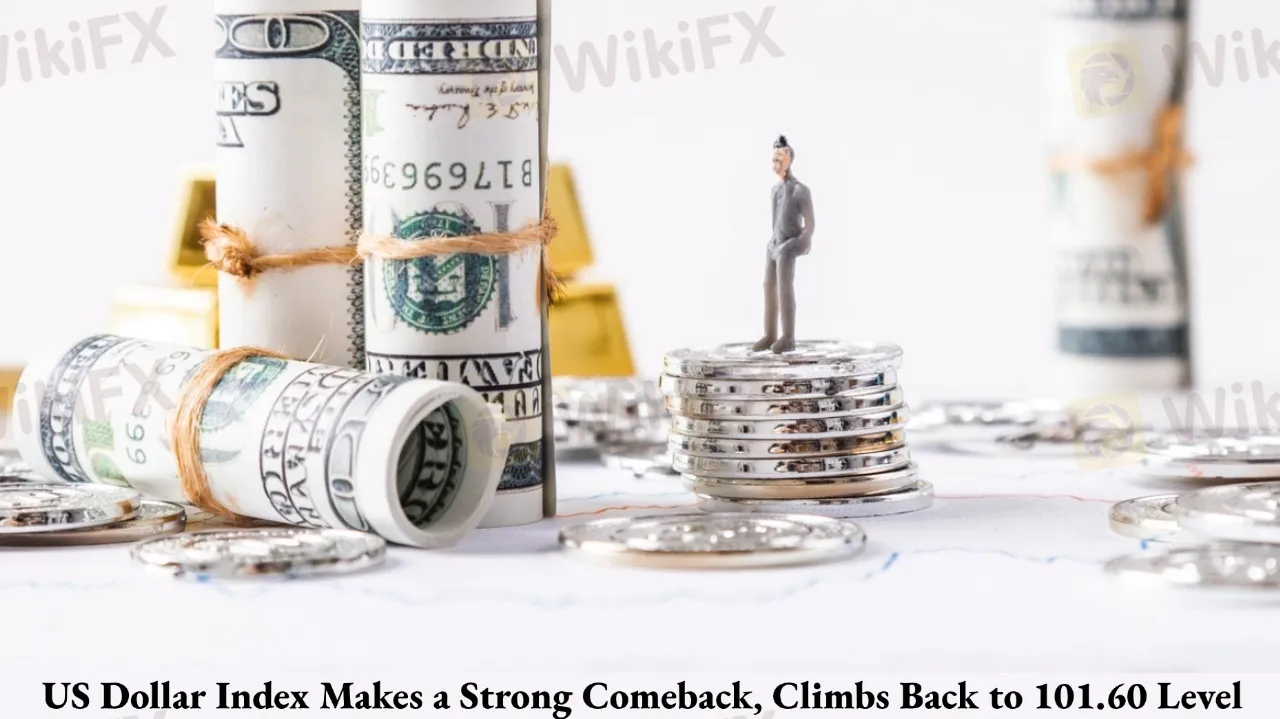简体中文
繁體中文
English
Pусский
日本語
ภาษาไทย
Tiếng Việt
Bahasa Indonesia
Español
हिन्दी
Filippiiniläinen
Français
Deutsch
Português
Türkçe
한국어
العربية
US Dollar Index Makes a Strong Comeback, Climbs Back to 101.60 Level
Abstract:The US Dollar Index has surged back above 101.60, breaking out of a multi-week consolidation. Boosted by trade truce optimism and technical breakouts, market sentiment has shifted sharply, placing investors at a crucial decision point.

On May 12, the US Dollar Index staged a powerful rally, reclaiming the key 101.60 level after weeks of lackluster movement. Since bottoming at 97.92 in late March, dollar bulls have been gathering strength but lacked a clear catalyst for breakout—until now. The recent surge reflects a meaningful shift in market sentiment, underpinned by changes in fundamental dynamics.
Dollar Regains Popularity
The immediate trigger for the rally was the announcement of a 90-day trade truce between China and the US, featuring significant tariff reductions. This development improved global trade prospects and boosted risk appetite across financial markets. Simultaneously, the US 10-year Treasury yield jumped to 4.45%, near highs not seen since early April. The widening interest rate differential between the US and other economies further enhanced the dollars relative appeal.
Expectations for a Federal Reserve rate cut were also quickly revised. According to CME FedWatch, the probability of a rate cut in June has dropped to just 7.9%, while July's odds have fallen to about 44.1%. This shift has helped reinforce the dollar's medium-term outlook and led investors to re-evaluate carry trade strategies.
Technically, the DXY has entered a clear upward channel on the daily chart, breaking above the 101.50 resistance and testing the 102.20 level. The MACD has formed a bullish crossover, the RSI stands at 56.53 (in a neutral-to-strong zone), and the CCI continues to rise—indicating strong momentum.
The appearance of a V-shaped bottom further strengthens confidence in a medium-term reversal. This confluence of technical and fundamental support makes a compelling case for dollar bulls. However, with the index nearing short-term overbought levels, some correction toward 101.20 or even 99.00 cannot be ruled out.
Investors Must Beware of Overexuberance
While the trade détente offers near-term relief, challenges remain. The Fed‘s policy path is still uncertain, and weak economic data in the future could reignite dovish expectations. Furthermore, the dollar’s sharp gains have triggered potential overbought signals, making a short-term pullback increasingly likely.
For investors, the key challenge lies in balancing optimism with risk awareness. The Fear & Greed Index has tilted sharply toward “Greed,” suggesting elevated risk of correction. Although institutional flows show growing long positions in the dollar—a typical sign of trend strength—investors should remain cautious of abrupt reversals.
The US Dollar Index‘s return above 101.60 showcases a strong rebound, but the road ahead is not without bumps. Investors entering long positions must remain vigilant, watch for technical corrections, and adjust strategies accordingly. A blend of macro awareness and technical discipline will be vital to navigating the next phase of this dollar cycle. Are you ready for what’s next in the USD comeback story?
Understanding the U.S. Dollar Index (DXY)
The U.S. Dollar Index (DXY) is a key benchmark that measures the value of the U.S. dollar against a basket of major global currencies. Created in 1973 by the Intercontinental Exchange (ICE), the index is designed to provide a broad indication of the dollars overall strength or weakness in the global market.
The DXY is composed of six currencies: the euro (EUR), Japanese yen (JPY), British pound (GBP), Canadian dollar (CAD), Swedish krona (SEK), and Swiss franc (CHF). However, these currencies are not weighted equally. Their weights are determined based on the volume of U.S. trade with the respective regions, making the euro the most influential, with a weight of approximately 57.6%. This is followed by the yen at 13.6%, the pound at 11.9%, and the remaining currencies at smaller percentages.
Because of this weighting system, movements in the euro have the most significant impact on the index. In simple terms, when the euro strengthens against the dollar, the DXY tends to decline. Conversely, a weaker euro often pushes the DXY higher.
You can think of this in terms of “distance of influence.” The euro is the closest to the “center” of influence, so its movements carry more weight. Currencies like the Swedish krona and Swiss franc are “further” from this center, meaning their impact on the index is relatively limited.
This structure explains why the U.S. dollar might appear strong against some currencies, but the DXY still falls if the euro is rallying. For traders and investors, understanding how the DXY is built and what drives it can help provide deeper insight into market sentiment and directional trends.
When analyzing dollar strength, monitoring the EUR/USD pair is especially critical. As the largest component of the index, its fluctuations can often foreshadow broader shifts in dollar performance. In summary, the DXY is not just a number—it‘s a reflection of the dollar’s position in a complex, weighted network of global currency relationships.

Disclaimer:
The views in this article only represent the author's personal views, and do not constitute investment advice on this platform. This platform does not guarantee the accuracy, completeness and timeliness of the information in the article, and will not be liable for any loss caused by the use of or reliance on the information in the article.
Read more

Global Guide to Finding Forex IBs/Brokers — Share Your Pick and Win Big!
Dear forex enthusiasts, are you also troubled by these questions? “In India, can’t find a reliable IB? What should I do?” “With so many brokers, which one offers the lowest spreads and fastest withdrawals?” “Want to connect with local forex enthusiasts but don’t know where to start?” Now, leave these challenges to us! Share your experience and win exciting rewards!

WikiFX Elite Club Committee Makes Its Debut, Charting the Future of the Global Trading Ecosystem
November 11, 2025 – The WikiFX Elite Club Committee (hereafter “the Elite Committee”) made its significant debut on the international stage at WikiEXPO Dubai 2025. Core members from the Middle East, Southeast Asia, and Chinese-speaking regions gathered to witness the beginning of a new chapter for the Elite Club.

WikiEXPO Dubai 2025 Concludes Successfully — Shaping a Transparent, Innovative Future
On November 11, WikiEXPO Dubai 2025, hosted by WikiGlobal and co-organized by WikiFX, successfully concluded. As one of the world’s most influential Fintech expos, this event brought together more than 570 regulatory representatives, industry leaders, and innovation pioneers from across the globe. Through in-depth discussions on core issues such as regulatory compliance, the forex market, investment strategies, and sustainable finance, the event delivered a profound experience that masterfully blended intellectual depth with actionable insights.

Russian crypto millionaire couple found dismembered and buried in Dubai desert
A gruesome case has emerged involving a Russian couple living in the United Arab Emirates who went missing in early October and whose remains were recently discovered in a desert near Dubai. Roman Novak, a self-styled cryptocurrency “millionaire”, and his wife Anna had last been seen travelling to a supposed investor meeting in the UAE, but according to investigators were instead abducted and murdered after a ransom plot failed.
WikiFX Broker
Latest News
Forex Expert Recruitment Event – Sharing Insights, Building Rewards
Admirals Cancels UAE License as Part of Global Restructuring
Moomoo Singapore Opens Investor Boutiques to Strengthen Community
OmegaPro Review: Traders Flood Comment Sections with Withdrawal Denials & Scam Complaints
An Unbiased Review of INZO Broker for Indian Traders: What You Must Know
BotBro’s “30% Return” Scheme Raises New Red Flags Amid Ongoing Fraud Allegations
The 5%ers Review: Is it a Scam or Legit? Find Out from These Trader Comments
WikiEXPO Dubai 2025 Concludes Successfully — Shaping a Transparent, Innovative Future
2 Malaysians Arrested in $1 Million Gold Scam Impersonating Singapore Officials
Is FXPesa Regulated? Real User Reviews & Regulation Check
Currency Calculator



